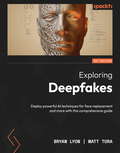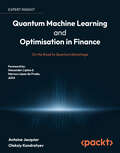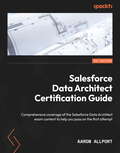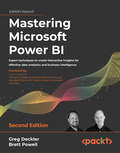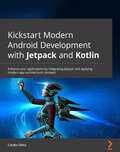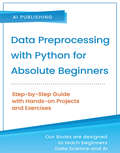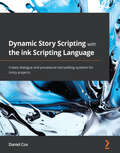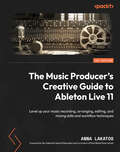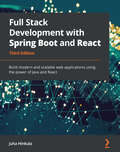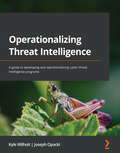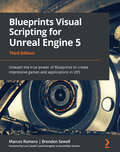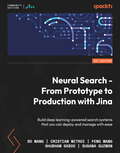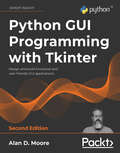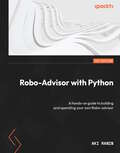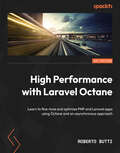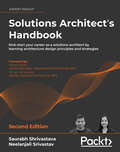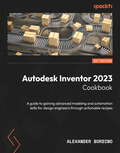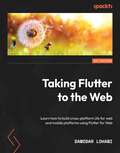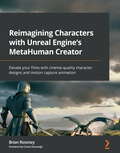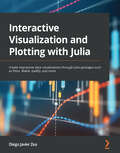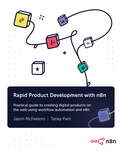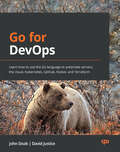- Table View
- List View
Exploring Deepfakes: Deploy powerful AI techniques for face replacement and more with this comprehensive guide
by Bryan Lyon Matt ToraMaster the innovative world of deepfakes and generative AI for face replacement with this full-color guidePurchase of the print or Kindle book includes a free PDF eBookKey FeaturesUnderstand what deepfakes are, their history, and how to use the technology ethicallyGet well-versed with the workflow and processes involved to create your own deepfakesLearn how to apply the lessons and techniques of deepfakes to your own problemsBook DescriptionApplying Deepfakes will allow you to tackle a wide range of scenarios creatively.Learning from experienced authors will help you to intuitively understand what is going on inside the model. You'll learn what deepfakes are and what makes them different from other machine learning techniques, and understand the entire process from beginning to end, from finding faces to preparing them, training the model, and performing the final swap.We'll discuss various uses for face replacement before we begin building our own pipeline. Spending some extra time thinking about how you collect your input data can make a huge difference to the quality of the final video. We look at the importance of this data and guide you with simple concepts to understand what your data needs to really be successful.No discussion of deepfakes can avoid discussing the controversial, unethical uses for which the technology initially became known. We'll go over some potential issues, and talk about the value that deepfakes can bring to a variety of educational and artistic use cases, from video game avatars to filmmaking.By the end of the book, you'll understand what deepfakes are, how they work at a fundamental level, and how to apply those techniques to your own needs.What you will learnGain a clear understanding of deepfakes and their creationUnderstand the risks of deepfakes and how to mitigate themCollect efficient data to create successful deepfakesGet familiar with the deepfakes workflow and its stepsExplore the application of deepfakes methods to your own generative needsImprove results by augmenting data and avoiding overtrainingExamine the future of deepfakes and other generative AIsUse generative AIs to increase video content resolutionWho this book is forThis book is for AI developers, data scientists, and anyone looking to learn more about deepfakes or techniques and technologies from Deepfakes to help them generate new image data. Working knowledge of Python programming language and basic familiarity with OpenCV, Pillow, Pytorch, or Tensorflow is recommended to get the most out of the book.
Quantum Machine Learning and Optimisation in Finance: On the Road to Quantum Advantage
by Antoine Jacquier Alexander Lipton Oleksiy Kondratyev Marcos Lopez PradoLearn the principles of quantum machine learning and how to apply them in finance.Purchase of the print or Kindle book includes a free eBook in the PDF format.Key FeaturesDiscover how to solve optimisation problems on quantum computers that can provide a speedup edge over classical methodsUse methods of analogue and digital quantum computing to build powerful generative modelsCreate the latest algorithms that work on Noisy Intermediate-Scale Quantum (NISQ) computersBook DescriptionWith recent advances in quantum computing technology, we finally reached the era of Noisy Intermediate-Scale Quantum (NISQ) computing. NISQ-era quantum computers are powerful enough to test quantum computing algorithms and solve hard real-world problems faster than classical hardware.Speedup is so important in financial applications, ranging from analysing huge amounts of customer data to high frequency trading. This is where quantum computing can give you the edge. Quantum Machine Learning and Optimisation in Finance shows you how to create hybrid quantum-classical machine learning and optimisation models that can harness the power of NISQ hardware.This book will take you through the real-world productive applications of quantum computing. The book explores the main quantum computing algorithms implementable on existing NISQ devices and highlights a range of financial applications that can benefit from this new quantum computing paradigm.This book will help you be one of the first in the finance industry to use quantum machine learning models to solve classically hard real-world problems. We may have moved past the point of quantum computing supremacy, but our quest for establishing quantum computing advantage has just begun!What you will learnTrain parameterised quantum circuits as generative models that excel on NISQ hardwareSolve hard optimisation problemsApply quantum boosting to financial applicationsLearn how the variational quantum eigensolver and the quantum approximate optimisation algorithms workAnalyse the latest algorithms from quantum kernels to quantum semidefinite programmingApply quantum neural networks to credit approvalsWho this book is forThis book is for Quants and developers, data scientists, researchers, and students in quantitative finance. Although the focus is on financial use cases, all the methods and techniques are transferable to other areas.
Salesforce Data Architect Certification Guide: Comprehensive coverage of the Salesforce Data Architect exam content to help you pass on the first attempt
by Aaron AllportLearn data architecture essentials and prepare for the Salesforce Certified Data Architect exam with the help of tips and mock test questionsKey FeaturesLeverage data modelling, Salesforce database design, and techniques for effective data designLearn master data management, Salesforce data management, and how to include considerationsGet to grips with large data volumes, performance tuning, and poor performance mitigation techniquesBook DescriptionThe Salesforce Data Architect is a prerequisite exam for the Application Architect half of the Salesforce Certified Technical Architect credential. This book offers complete, up-to-date coverage of the Salesforce Data Architect exam so you can take it with confidence.The book is written in a clear, succinct way with self-assessment and practice exam questions, covering all the topics necessary to help you pass the exam with ease. You'll understand the theory around Salesforce data modeling, database design, master data management (MDM), Salesforce data management (SDM), and data governance. Additionally, performance considerations associated with large data volumes will be covered. You'll also get to grips with data migration and understand the supporting theory needed to achieve Salesforce Data Architect certification.By the end of this Salesforce book, you'll have covered everything you need to know to pass the Salesforce Data Architect certification exam and have a handy, on-the-job desktop reference guide to re-visit the concepts.What you will learnUnderstand the topics relevant to passing the Salesforce Data Architect examExplore specialist areas, such as large data volumesTest your knowledge with the help of exam-like questionsPick up useful tips and tricks that can be referred to time and againUnderstand the reasons underlying the way Salesforce data management worksDiscover the techniques that are available for loading massive amounts of dataWho this book is forThis book is for both aspiring Salesforce data architects and those already familiar with Salesforce data architecture who want to pass the exam and have a reference guide to revisit the material as part of their day-to-day job. Working knowledge of the Salesforce platform is assumed, alongside a clear understanding of Salesforce architectural concepts.
Mastering Microsoft Power BI: Expert techniques to create interactive insights for effective data analytics and business intelligence, 2nd Edition
by Brett Powell Greg DecklerPlan, design, develop, and manage robust Power BI solutions to generate meaningful insights and make data-driven decisionsKey FeaturesMaster the latest dashboarding and reporting features of Microsoft Power BICombine data from multiple sources, create stunning visualizations and publish Power BI apps to thousands of usersGet the most out of Microsoft Power BI with real-world use cases and examplesBook DescriptionMastering Microsoft Power BI, Second Edition, provides an advanced understanding of Power BI to get the most out of your data and maximize business intelligence. This updated edition walks through each essential phase and component of Power BI, and explores the latest, most impactful Power BI features. Using best practices and working code examples, you will connect to data sources, shape and enhance source data, and develop analytical data models. You will also learn how to apply custom visuals, implement new DAX commands and paginated SSRS-style reports, manage application workspaces and metadata, and understand how content can be staged and securely distributed via Power BI apps. Furthermore, you will explore top report and interactive dashboard design practices using features such as bookmarks and the Power KPI visual, alongside the latest capabilities of Power BI mobile applications and self-service BI techniques. Additionally, important management and administration topics are covered, including application lifecycle management via Power BI pipelines, the on-premises data gateway, and Power BI Premium capacity. By the end of this Power BI book, you will be confident in creating sustainable and impactful charts, tables, reports, and dashboards with any kind of data using Microsoft Power BI.What you will learnBuild efficient data retrieval and transformation processes with the Power Query M language and dataflowsDesign scalable, user-friendly DirectQuery, import, and composite data modelsCreate basic and advanced DAX measuresAdd ArcGIS Maps to create interesting data storiesBuild pixel-perfect paginated reportsDiscover the capabilities of Power BI mobile applicationsManage and monitor a Power BI environment as a Power BI administratorScale up a Power BI solution for an enterprise via Power BI Premium capacityWho this book is forBusiness Intelligence professionals and intermediate Power BI users looking to master Power BI for all their data visualization and dashboarding needs will find this book useful. An understanding of basic BI concepts is required and some familiarity with Microsoft Power BI will be helpful to make the most out of this book.
Kickstart Modern Android Development with Jetpack and Kotlin: Enhance your applications by integrating Jetpack and applying modern app architectural concepts
by Catalin GhitaExplore modern Android development in Kotlin 1.6.10 with this condensed hands-on guide to building reliable apps using libraries such as Compose, ViewModel, Hilt, Retrofit, Flow, and moreKey FeaturesExplore Jetpack libraries and other modern technologies for Android developmentImprove the architectural design of your Android appsEnhance the quality of your Android projects' code bases and applications using the latest librariesBook DescriptionWith Jetpack libraries, you can build and design high-quality, robust Android apps that have an improved architecture and work consistently across different versions and devices. This book will help you understand how Jetpack allows developers to follow best practices and architectural patterns when building Android apps while also eliminating boilerplate code. Developers working with Android and Kotlin will be able to put their knowledge to work with this condensed practical guide to building apps with the most popular Jetpack libraries, including Jetpack Compose, ViewModel, Hilt, Room, Paging, Lifecycle, and Navigation. You'll get to grips with relevant libraries and architectural patterns, including popular libraries in the Android ecosystem such as Retrofit, Coroutines, and Flow while building modern applications with real-world data. By the end of this Android app development book, you'll have learned how to leverage Jetpack libraries and your knowledge of architectural concepts for building, designing, and testing robust Android applications for various use cases.What you will learnIntegrate popular Jetpack libraries such as Compose, ViewModel, Hilt, and Navigation into real Android apps with KotlinApply modern app architecture concepts such as MVVM, dependency injection, and clean architectureExplore Android libraries such as Retrofit, Coroutines, and FlowIntegrate Compose with the rest of the Jetpack libraries or other popular Android librariesWork with other Jetpack libraries such as Paging and Room while integrating a real REST API that supports paginationTest Compose UI and the application logic through unit testsWho this book is forThis book is for junior and intermediate-level Android developers looking to level up their Android development skills to develop high-quality apps using Jetpack libraries and other cutting-edge technologies. Beginners with knowledge of Android development fundamentals will also find this book useful. Familiarity with Kotlin is assumed.
Data Preprocessing with Python for Absolute Beginners: Take your first steps in data preparation with Python
by AI Sciences OUThis book is dedicated to data preparation and explains how to perform different data preparation techniques on various datasets using different data preparation libraries written in the Python programming language.Key FeaturesA crash course in Python to fill any gaps in prerequisite knowledge and a solid foundation on which to build your new skillsA complete data preparation pipeline for your guided practiceThree real-world projects covering each major task to cement your learned skills in data preparation, classification, and regressionBook DescriptionThe book follows a straightforward approach. It is divided into nine chapters. Chapter 1 introduces the basic concept of data preparation and installation steps for the software that we will need to perform data preparation in this book. Chapter 1 also contains a crash course on Python, followed by a brief overview of different data types in Chapter 2. You will then learn how to handle missing values in the data, while the categorical encoding of numeric data is explained in Chapter 4.The second half of the course presents data discretization and describes the handling of outliers' process. Chapter 7 demonstrates how to scale features in the dataset. Subsequent chapters teach you to handle mixed and DateTime data type, balance data, and practice resampling. A full data preparation final project is also available at the end of the book.Different types of data preprocessing techniques have been explained theoretically, followed by practical examples in each chapter. Each chapter also contains an exercise that students can use to evaluate their understanding of the chapter's concepts. By the end of this course, you will have built a solid working knowledge in data preparation--the first steps to any data science or machine learning career and an essential skillset for any aspiring developer.The code bundle for this course is available at https://www.aispublishing.net/book-data-preprocessingWhat you will learnExplore different libraries for data preparationUnderstand data typesHandle missing dataEncode categorical dataDiscretize dataLearn to handle outliersPractice feature scalingHandle mixed and DateTime variables and imbalanced datasetsEmploy your new skills to complete projects in data preparation, classification, and regressionWho this book is forIn addition to beginners in data preparation with Python, this book can also be used as a reference manual by intermediate and experienced programmers. It contains data preprocessing code samples using multiple data visualization libraries.
How to Test a Time Machine: A practical guide to test architecture and automation
by Noemi Ferrera Joe ColantonioRev up your career with powerful project enhancements using this comprehensive guide to test architectures and methodologies applicable to every area of testingPurchase of the print or Kindle book includes a free PDF eBookKey FeaturesExplore the full test architecture spectrumDiscover a range of challenging automation applications with real-world scenariosLearn with easy-to-follow start-up examples including DevOps for testing, AI, XR, and cloudBook DescriptionFrom simple websites to complex applications, delivering quality is crucial for achieving customer satisfaction. How to Test a Time Machine provides step-by-step explanations of essential concepts and practical examples to show you how you can leverage your company's test architecture from different points in the development life cycle.You'll begin by determining the most effective system for measuring and improving the delivery of quality applications for your company, and then learn about the test pyramid as you explore it in an innovative way. You'll also cover other testing topics, including cloud, AI, and VR for testing.Complete with techniques, patterns, tools, and exercises, this book will help you enhance your understanding of the testing process. Regardless of your current role within development, you can use this book as a guide to learn all about test architecture and automation and become an expert and advocate for quality assurance.By the end of this book, you'll be able to deliver high-quality applications by implementing the best practices and testing methodologies included in the book.What you will learnIdentify quality maturity levels and processes to step up your product qualityDevelop the ability to think outside the box when testing methodologiesExamine the various types of tests and their applications from an unconventional perspectiveUnderstand how to apply different technologies to the testing processPractice and polish your testing skills with practical code exercisesExpedite your career growth with quality assuranceWho this book is forThis book is for test owners, developers, managers, manual QAs, SDETS, team leads, and systems engineers who wish to get started or improve the current QA systems. Test owners looking for inspiration and out-of-the-box solutions for challenging issues will also find this book useful.
Dynamic Story Scripting with the ink Scripting Language: Create dialogue and procedural storytelling systems for Unity projects
by Daniel CoxBring your stories to life by combining the narrative scripting language, ink, with a plugin to build dialogue, quest, and procedural storytelling systems for Unity projectsKey FeaturesLearn how to translate stories into ink code to create interactive projectsGain valuable insight into the ink story API to create engaging stories using the Unity pluginDevelop drop-in solutions to common narrative problems for Unity projectsBook Descriptionink is a narrative scripting language designed for use with game engines such as Unity through a plugin that provides an application programming interface (API) to help you to move between the branches of a story and access the values within it. Hands-On Dynamic Story Scripting with the ink Scripting Language begins by showing you how ink understands stories and how to write some simple branching projects. You'll then move on to advanced usage with looping structures, discovering how to use variables to set up dynamic events in a story and defining simple rules to create complex narratives for use with larger Unity projects. As you advance, you'll learn how the Unity plugin allows access to a running story through its API and explore the ways in which this can be used to move data in and out of an ink story to adapt to different interactions and forms of user input. You'll also work with three specific use cases of ink with Unity by writing a dialogue system and creating quest structures and other branching narrative patterns. Finally, this will help you to find out how ink can be used to generate procedural storytelling patterns for Unity projects using different forms of data input. By the end of this book, you will be able to move from a simple story to an intricate Unity project using ink to power complex narrative structures.What you will learnDiscover how ink understands stories and their partsExamine ink patterns for making branching narrativesDevelop code in Unity using the ink plugin to manipulate storiesDesign advanced projects combining ink stories with C# codeCompare common use cases for ink and Unity, such as dialogue systemsDetermine how ink can best fit into future narrative projectsWho this book is forThis book is for Unity developers looking for a solution for narrative-driven projects and authors who want to create interactive story projects in Unity. Basic knowledge of Unity game engine development and related concepts is needed to get the most out of this book.
The Music Producer's Creative Guide to Ableton Live 11: Level up your music recording, arranging, editing, and mixing skills and workflow techniques
by Anna Lakatos Ski OakenfullExpert guidance on enhancing your live music production skills with MIDI, audio sequencing and arrangement techniques, automation, modulation, MPE, and external instruments from an Ableton Certified TrainerKey FeaturesMake the most of Ableton Live 11 tools and processes to create, record and edit your own musicEngage with non-linear workflow for both music production and live performanceUnveil the best solutions to common pitfalls and mistakes committed by Ableton Live usersPurchase of the print or Kindle book includes a free PDF eBookBook DescriptionThe Music Producer's Guide to Ableton Live will help you sharpen your production skills and gain a deeper understanding of the Live workflow. If you are a music maker working with other digital audios workstations (DAWs) or experienced in Ableton Live, perhaps earlier versions, you'll be able to put your newfound knowledge to use right away with this book.You'll start with some basic features and workflows that are more suitable for producers from another DAW looking to transfer their skills to Ableton Live 11.2. As you explore the Live concept, you'll learn to create expressive music using Groove and MIDI effects and demystify Live 11's new workflow improvements, such as Note Chance and Velocity Randomization. The book then introduces the Scale Mode, MIDI Transform tools, and other key features that can make composition and coming up with melodic elements easier than ever before. It will also guide you in implementing Live 11's new and updated effects into your current workflow.By the end of this Ableton Live book, you'll be able to implement advanced production and workflow techniques and amplify live performance capabilities with what the Live 11 workflow has to offer.What you will learnUnderstand the concept of Live, the workflow of recording and editing audio and MIDI, and warpingUse Groove, MIDI effects, and Live 11's new workflow enhancements to create innovative musicUse audio to MIDI conversion tools to translate and generate ideas quicklyEmploy Live's automation and modulation capabilities and project organization techniques to speed up your workflowUtilize MIDI Polyphonic Expression to create evolving sounds and texturesAdopt advanced techniques for production and discover the capabilities of live performanceWho this book is forIf you are a music producer, enthusiast, or hobbyist with a basic understanding of using Ableton Live for simple projects, this Ableton Live 11 book will help you improve your skills to employ the best features and techniques in your projects. This book is also for producers familiar with other DAWs looking to leverage their transferable skills to learn Ableton Live.
Full Stack Development with Spring Boot and React: Build modern and scalable web applications using the power of Java and React, 3rd Edition
by Juha HinkulaDiscover the secrets to creating cutting-edge, compelling full stack applications using Spring Boot and React's rich and varied toolsetsKey FeaturesUtilize Spring Boot to make powerful, complex, and secure backends for your applicationsLeverage React's full arsenal of tools for building slick, high-performance frontendsBuild modern, scalable full stack applications that comfortably meet the demands of your usersBook DescriptionGetting started with full stack development can be daunting. Even developers who are familiar with the best tools, such as Spring Boot and React, can struggle to nail the basics, let alone master the more advanced elements. If you're one of these developers, this comprehensive guide covers everything you need!This updated edition of the Full Stack Development with Spring Boot 2 and React book will take you from novice to proficient in this expansive domain. Taking a practical approach, this book will first walk you through the latest Spring Boot features for creating a robust backend, covering everything from setting up the environment and dependency injection to security and testing.Once this has been covered, you'll advance to React frontend programming. If you've ever wondered about custom Hooks, third-party components, and MUI, this book will demystify all that and much more. You'll explore everything that goes into developing, testing, securing, and deploying your applications using all the latest tools from Spring Boot, React, and other cutting-edge technologies.By the end of this book, you'll not only have learned the theory of building modern full stack applications but also have developed valuable skills that add value in any setting.What you will learnMake fast and RESTful web services powered by Spring Data RESTCreate and manage databases using ORM, JPA, Hibernate, and moreExplore the use of unit tests and JWTs with Spring SecurityEmploy React Hooks, props, states, and more to create your frontendDiscover a wide array of advanced React and third-party componentsBuild high-performance applications complete with CRUD functionalityHarness MUI to customize your frontendTest, secure, and deploy your applications with high efficiencyWho this book is forThis book is for Java developers who are familiar with Spring Boot but don't know where to start when it comes to building full stack applications. You'll also find this book useful if you're a frontend developer with knowledge of JavaScript basics looking to learn full stack development or a full stack developer experienced in other technology stacks looking to learn a new one.
Operationalizing Threat Intelligence: A guide to developing and operationalizing cyber threat intelligence programs
by Kyle Wilhoit Joseph OpackiLearn cyber threat intelligence fundamentals to implement and operationalize an organizational intelligence programKey FeaturesDevelop and implement a threat intelligence program from scratchDiscover techniques to perform cyber threat intelligence, collection, and analysis using open-source toolsLeverage a combination of theory and practice that will help you prepare a solid foundation for operationalizing threat intelligence programsBook DescriptionWe're living in an era where cyber threat intelligence is becoming more important. Cyber threat intelligence routinely informs tactical and strategic decision-making throughout organizational operations. However, finding the right resources on the fundamentals of operationalizing a threat intelligence function can be challenging, and that's where this book helps. In Operationalizing Threat Intelligence, you'll explore cyber threat intelligence in five fundamental areas: defining threat intelligence, developing threat intelligence, collecting threat intelligence, enrichment and analysis, and finally production of threat intelligence. You'll start by finding out what threat intelligence is and where it can be applied. Next, you'll discover techniques for performing cyber threat intelligence collection and analysis using open source tools. The book also examines commonly used frameworks and policies as well as fundamental operational security concepts. Later, you'll focus on enriching and analyzing threat intelligence through pivoting and threat hunting. Finally, you'll examine detailed mechanisms for the production of intelligence. By the end of this book, you'll be equipped with the right tools and understand what it takes to operationalize your own threat intelligence function, from collection to production.What you will learnDiscover types of threat actors and their common tactics and techniquesUnderstand the core tenets of cyber threat intelligenceDiscover cyber threat intelligence policies, procedures, and frameworksExplore the fundamentals relating to collecting cyber threat intelligenceUnderstand fundamentals about threat intelligence enrichment and analysisUnderstand what threat hunting and pivoting are, along with examplesFocus on putting threat intelligence into productionExplore techniques for performing threat analysis, pivoting, and huntingWho this book is forThis book is for cybersecurity professionals, security analysts, security enthusiasts, and anyone who is just getting started and looking to explore threat intelligence in more detail. Those working in different security roles will also be able to explore threat intelligence with the help of this security book.
Blueprints Visual Scripting for Unreal Engine 5: Unleash the true power of Blueprints to create impressive games and applications in UE5, 3rd Edition
by Brenden Sewell Marcos RomeroExplore the faster way to build games using UE5 Blueprints using this practical guide with key images printed in colorKey FeaturesDesign a fully functional game in UE5 without writing a single line of codeImplement visual scripting to develop gameplay mechanics, UI, visual effects, VR, and artificial intelligenceDeploy your game on multiple platforms and share it with the worldBook DescriptionUnreal Engine's Blueprint visual scripting system enables designers to script their games and programmers to create base elements that can be extended by designers. With this book, you'll explore all the features of the Blueprint Editor, along with expert tips, shortcuts, and best practices.The book guides you through using variables, macros, and functions, and helps you learn about object-oriented programming (OOP). You'll discover the Gameplay Framework and advance to learning how Blueprint Communication allows one Blueprint to access information from another Blueprint. Later chapters focus on building a fully functional game step by step. You'll start with a basic first-person shooter (FPS) template, and each chapter will build on the prototype to create an increasingly complex and robust game experience. You'll then progress from creating basic shooting mechanics to more complex systems such as user interface elements and intelligent enemy behavior. The book demonstrates how to use arrays, maps, enums, and vector operations and introduces the elements needed for VR game development. In the final chapters, you'll learn how to implement procedural generation and create a product configurator.By the end of this book, you'll have learned how to build a fully functional game and have the skills required to develop an entertaining experience for your audience.What you will learnUnderstand programming concepts in BlueprintsCreate prototypes and iterate new game mechanics rapidlyBuild user interface elements and interactive menusUse advanced Blueprint nodes to manage the complexity of a gameExplore all the features of the Blueprint editor, such as the Components tab, Viewport, and Event GraphGet to grips with OOP concepts and explore the Gameplay FrameworkWork with virtual reality development in UE BlueprintImplement procedural generation and create a product configuratorWho this book is forThis book is for anyone interested in developing games or applications with UE5. Although basic knowledge of Windows OS is required, experience in programming or UE5 is not necessary.
Blueprints Visual Scripting for Unreal Engine 5: Unleash the true power of Blueprints to create impressive games and applications in UE5
by Marcos Romero Brenden SewellExplore the faster way to build games using UE5 Blueprints using this practical guide with key images printed in colorKey FeaturesDesign a fully functional game in UE5 without writing a single line of codeImplement visual scripting to develop gameplay mechanics, UI, visual effects, VR, and artificial intelligenceDeploy your game on multiple platforms and share it with the worldBook DescriptionUnreal Engine's Blueprint visual scripting system enables designers to script their games and programmers to create base elements that can be extended by designers. With this book, you'll explore all the features of the Blueprint Editor, along with expert tips, shortcuts, and best practices. The book guides you through using variables, macros, and functions, and helps you learn about object-oriented programming (OOP). You'll discover the Gameplay Framework and advance to learning how Blueprint Communication allows one Blueprint to access information from another Blueprint. Later chapters focus on building a fully functional game step by step. You'll start with a basic first-person shooter (FPS) template, and each chapter will build on the prototype to create an increasingly complex and robust game experience. You'll then progress from creating basic shooting mechanics to more complex systems such as user interface elements and intelligent enemy behavior. The book demonstrates how to use arrays, maps, enums, and vector operations and introduces the elements needed for VR game development. In the final chapters, you’ll learn how to implement procedural generation and create a product configurator. By the end of this book, you'll have learned how to build a fully functional game and have the skills required to develop an entertaining experience for your audience.What you will learnUnderstand programming concepts in BlueprintsCreate prototypes and iterate new game mechanics rapidlyBuild user interface elements and interactive menusUse advanced Blueprint nodes to manage the complexity of a gameExplore all the features of the Blueprint editor, such as the Components tab, Viewport, and Event GraphGet to grips with OOP concepts and explore the Gameplay FrameworkWork with virtual reality development in UE BlueprintImplement procedural generation and create a product configuratorWho this book is forThis book is for anyone interested in developing games or applications with UE5. Although basic knowledge of Windows OS is required, experience in programming or UE5 is not necessary.
Neural Search - From Prototype to Production with Jina: Build deep learning–powered search systems that you can deploy and manage with ease
by Bo Wang Cristian Mitroi Feng Wang Shubham Saboo Susana GuzmanImplement neural search systems on the cloud by leveraging Jina design patternsKey FeaturesIdentify the different search techniques and discover applications of neural searchGain a solid understanding of vector representation and apply your knowledge in neural searchUnlock deeper levels of knowledge of Jina for neural searchBook DescriptionSearch is a big and ever-growing part of the tech ecosystem. Traditional search, however, has limitations that are hard to overcome because of the way it is designed. Neural search is a novel approach that uses the power of machine learning to retrieve information using vector embeddings as first-class citizens, opening up new possibilities of improving the results obtained through traditional search. Although neural search is a powerful tool, it is new and finetuning it can be tedious as it requires you to understand the several components on which it relies. Jina fills this gap by providing an infrastructure that reduces the time and complexity involved in creating deep learning–powered search engines. This book will enable you to learn the fundamentals of neural networks for neural search, its strengths and weaknesses, as well as how to use Jina to build a search engine. With the help of step-by-step explanations, practical examples, and self-assessment questions, you'll become well-versed with the basics of neural search and core Jina concepts, and learn to apply this knowledge to build your own search engine. By the end of this deep learning book, you'll be able to make the most of Jina's neural search design patterns to build an end-to-end search solution for any modality.What you will learnUnderstand how neural search and legacy search workGrasp the machine learning and math fundamentals needed for neural searchGet to grips with the foundation of vector representationExplore the basic components of JinaAnalyze search systems with different modalitiesUncover the capabilities of Jina with the help of practical examplesWho this book is forIf you are a machine learning, deep learning, or artificial intelligence engineer interested in building a search system of any kind (text, QA, image, audio, PDF, 3D models, or others) using modern software architecture, this book is for you. This book is perfect for Python engineers who are interested in building a search system of any kind using state-of-the-art deep learning techniques.
Python GUI Programming with Tkinter: Design and build functional and user-friendly GUI applications, 2nd Edition
by Alan D. MooreTransform your evolving user requirements into feature-rich Tkinter applicationsKey FeaturesExtensively revised with new content on RESTful networking, classes in Tkinter, and the Notebook widgetTake advantage of Tkinter's lightweight, portable, and easy-to-use featuresBuild better-organized code and learn to manage an evolving codebaseBook DescriptionTkinter is widely used to build GUIs in Python due to its simplicity. In this book, you'll discover Tkinter's strengths and overcome its challenges as you learn to develop fully featured GUI applications.Python GUI Programming with Tkinter, Second Edition, will not only provide you with a working knowledge of the Tkinter GUI library, but also a valuable set of skills that will enable you to plan, implement, and maintain larger applications. You'll build a full-blown data entry application from scratch, learning how to grow and improve your code in response to continually changing user and business needs.You'll develop a practical understanding of tools and techniques used to manage this evolving codebase and go beyond the default Tkinter widget capabilities. You'll implement version control and unit testing, separation of concerns through the MVC design pattern, and object-oriented programming to organize your code more cleanly.You'll also gain experience with technologies often used in workplace applications, such as SQL databases, network services, and data visualization libraries. Finally, you'll package your application for wider distribution and tackle the challenge of maintaining cross-platform compatibility.What you will learnProduce well-organized, functional, and responsive GUI applicationsExtend the functionality of existing widgets using classes and OOPPlan wisely for the expansion of your app using MVC and version controlMake sure your app works as intended through widget validation and unit testingUse tools and processes to analyze and respond to user requestsBecome familiar with technologies used in workplace applications, including SQL, HTTP, Matplotlib, threading, and CSVUse PostgreSQL authentication to ensure data security for your applicationWho this book is forThis book is for programmers who understand the syntax of Python, but do not yet have the skills, techniques, and knowledge to design and implement a complete software application. A fair grasp of basic Python syntax is required.
Robo-Advisor with Python: A hands-on guide to building and operating your own Robo-advisor
by Aki RaninBuild your own robo-advisor in Python to manage your investments and get up and running in no timePurchase of the print or Kindle book includes a free PDF eBookKey FeaturesExplore the use cases, workflow, and features that make up robo-advisorsLearn how to build core robo-advisor capabilities for goals, risk questions, portfolios, and projectionsDiscover how to operate the automated processes of a built and deployed robo-advisorBook DescriptionRobo-advisors are becoming table stakes for the wealth management industry across all segments, from retail to high-net-worth investors. Robo-advisors enable you to manage your own portfolios and financial institutions to create automated platforms for effective digital wealth management. This book is your hands-on guide to understanding how Robo-advisors work, and how to build one efficiently. The chapters are designed in a way to help you get a comprehensive grasp of what Robo-advisors do and how they are structured with an end-to-end workflow. You'll begin by learning about the key decisions that influence the building of a Robo-advisor, along with considerations on building and licensing a platform. As you advance, you'll find out how to build all the core capabilities of a Robo-advisor using Python, including goals, risk questionnaires, portfolios, and projections. The book also shows you how to create orders, as well as open accounts and perform KYC verification for transacting. Finally, you'll be able to implement capabilities such as performance reporting and rebalancing for operating a Robo-advisor with ease. By the end of this book, you'll have gained a solid understanding of how Robo-advisors work and be well on your way to building one for yourself or your business.What you will learnExplore what Robo-advisors do and why they existCreate a workflow to design and build a Robo-advisor from the bottom upBuild and license Robo-advisors using different approachesOpen and fund accounts, complete KYC verification, and manage ordersBuild Robo-advisor features for goals, projections, portfolios, and moreOperate a Robo-advisor with P&L, rebalancing, and fee managementWho this book is forIf you are a finance professional or a data professional working in wealth management and are curious about how robo-advisors work, this book is for you. It will be helpful to have a basic understanding of Python and investing concepts. This is a great handbook for developers interested in building their own robo-advisor to manage personal investments or build a platform for their business to operate, as well as for product managers and business leaders in financial services looking to lease, buy, or build a robo-advisor.
The Ultimate Kali Linux Book: Perform advanced penetration testing using Nmap, Metasploit, Aircrack-ng, and Empire, 2nd Edition
by Glen D. SinghExplore the latest ethical hacking tools and techniques to perform penetration testing from scratchKey FeaturesLearn to compromise enterprise networks with Kali LinuxGain comprehensive insights into security concepts using advanced real-life hacker techniquesUse Kali Linux in the same way ethical hackers and penetration testers do to gain control of your environmentBook DescriptionKali Linux is the most popular and advanced penetration testing Linux distribution within the cybersecurity industry. Using Kali Linux, a cybersecurity professional will be able to discover and exploit various vulnerabilities and perform advanced penetration testing on both enterprise wired and wireless networks.This book is a comprehensive guide for those who are new to Kali Linux and penetration testing that will have you up to speed in no time. Using real-world scenarios, you'll understand how to set up a lab and explore core penetration testing concepts. Throughout this book, you'll focus on information gathering and even discover different vulnerability assessment tools bundled in Kali Linux. You'll learn to discover target systems on a network, identify security flaws on devices, exploit security weaknesses and gain access to networks, set up Command and Control (C2) operations, and perform web application penetration testing. In this updated second edition, you'll be able to compromise Active Directory and exploit enterprise networks. Finally, this book covers best practices for performing complex web penetration testing techniques in a highly secured environment.By the end of this Kali Linux book, you'll have gained the skills to perform advanced penetration testing on enterprise networks using Kali Linux.What you will learnExplore the fundamentals of ethical hackingUnderstand how to install and configure Kali LinuxPerform asset and network discovery techniquesFocus on how to perform vulnerability assessmentsExploit the trust in Active Directory domain servicesPerform advanced exploitation with Command and Control (C2) techniquesImplement advanced wireless hacking techniquesBecome well-versed with exploiting vulnerable web applicationsWho this book is forThis pentesting book is for students, trainers, cybersecurity professionals, cyber enthusiasts, network security professionals, ethical hackers, penetration testers, and security engineers. If you do not have any prior knowledge and are looking to become an expert in penetration testing using the Kali Linux operating system (OS), then this book is for you.
High Performance with Laravel Octane: Learn to fine-tune and optimize PHP and Laravel apps using Octane and an asynchronous approach
by Roberto ButtiExplore tools, techniques, and practices to remove performance bottlenecks and enhance the stability of your Laravel and PHP web applicationsKey FeaturesGet a complete view of what it takes to design and build a high-performing application with OctaneReuse objects across requests and execute application logic asynchronouslyLearn key elements to design and build a performance-optimized and production-ready applicationBook DescriptionLaravel Octane is a very powerful component in the Laravel ecosystem that can help you achieve remarkable app performance. With Laravel Octane, you will find tools (queues, cache, and tables) that facilitate a new asynchronous approach for improving application performance. This book highlights how Laravel Octane works, what steps to take in designing an application from the start, what tools you have at your disposal, and how to set up production environments. It provides complete coverage of the strategies, tools, and best practices to make your apps scalable and performant. This is especially important as optimization is usually the overlooked part in the application development lifecycle. You will explore the asynchronous approach in Laravel and be able to release high-performing applications that have a positive impact on the end-user experience. By the end of this book, you will find yourself designing, developing, and releasing high-performance applications.What you will learnUnderstand the dynamics of the request life cycle in a classic Laravel applicationExplore possibilities with OpenSwoole and Roadrunner and choose the best solution for your applicationAnalyze the potential bottlenecks of a classic web applicationConfigure Laravel Octane with Roadrunner and OpenSwooleImplement functionality using asynchronous mechanisms and run tasks in parallel in the Laravel appPrepare the production environment to host Laravel Octane and its dependenciesUnderstand the pros and cons of applying potential enhancements to your Laravel appWho this book is forThe book is for existing Laravel developers who want to improve their software architecture, from a basic or standard architecture to a more scalable and performant one. Basic knowledge of Laravel fundamentals is required.
Solutions Architect's Handbook: Kick-start your career as a solutions architect by learning architecture design principles and strategies, 2nd Edition
by Saurabh Shrivastava Neelanjali Srivastav Rajesh Sheth Rohan Karmarkar Kamal AroraFrom fundamentals and design patterns to the different strategies for creating secure and reliable architectures in AWS cloud, learn everything you need to become a successful solutions architect.Purchase of the print or Kindle book includes a free eBook in the PDF format.Endorsements"For new or existing solutions architects looking to keep their skills sharp in the cloud era, this book hits all the key areas."-Rajesh Sheth, GM, Messaging and Streaming, AWS"...the go-to guide for understanding various functions in the age of cloud computing."-Rohan Karmarkar, Director, Solutions Architecture, AWS"...you will find very important nuggets of knowledge that will help you be a successful solutions architect, and open up a new world of infinite possibilities!"-Kamal Arora, Senior Manager, Solutions Architecture, AWSBook DescriptionBecoming a solutions architect requires a hands-on approach, and this edition of the Solutions Architect's Handbook brings exactly that. This handbook will teach you how to create robust, scalable, and fault-tolerant solutions and next-generation architecture designs in a cloud environment. It will also help you build effective product strategies for your business and implement them from start to finish.This new edition features additional chapters on disruptive technologies, such as Internet of Things (IoT), quantum computing, data engineering, and machine learning. It also includes updated discussions on cloud-native architecture, blockchain data storage, and mainframe modernization with public cloud.The Solutions Architect's Handbook provides an understanding of solution architecture and how it fits into an agile enterprise environment. It will take you through the journey of solution architecture design by providing detailed knowledge of design pillars, advanced design patterns, anti-patterns, and the cloud-native aspects of modern software design.By the end of this handbook, you'll have learned the techniques needed to create efficient architecture designs that meet your business requirements.What you will learnExplore the various roles of a solutions architect in the enterprise landscapeImplement key design principles and patterns to build high-performance cost-effective solutionsChoose the best strategies to secure your architectures and increase their availabilityModernize legacy applications with the help of cloud integrationUnderstand how big data processing, machine learning, and IoT fit into modern architectureIntegrate a DevOps mindset to promote collaboration, increase operational efficiency, and streamline productionWho this book is forThis book is for software developers, system engineers, DevOps engineers, architects, and team leaders who already work in the IT industry and aspire to become solutions architect professionals.Existing solutions architects who want to expand their skillset or get a better understanding of new technologies will also learn valuable new skills.To get started, you'll need a good understanding of the real-world software development process and general programming experience in any language.
Autodesk Inventor 2023 Cookbook: A guide to gaining advanced modeling and automation skills for design engineers through actionable recipes
by Alexander BordinoWith a recipe-based approach, hone and develop the necessary skills you need to perform mechanical, visualization, and simulation tasks using Autodesk InventorKey FeaturesCreate powerful parametric 3D designs, parts, and assembliesApply effective modeling techniques to increase automation and promote configurationEnable iLogic-powered rapid configurations and apply Finite Element Analysis for model simulationBook DescriptionAutodesk Inventor is an industry-leading, computer-aided design application for 3D mechanical design, simulation, visualization, and documentation. This book will help to bridge the gap between the fundamentals of this software and the more advanced features, workflows, and environments it has to offer.Using cookbook-style recipes, you'll gain a comprehensive understanding and practical experience in creating dynamic 3D parts, assemblies, and complete designs. You'll also explore a variety of topics, including automation and parametric techniques, collaboration tools, creating sheet metal designs, and design accelerators such as frame generators. As you progress, the chapters will guide you through surface modeling tools, advanced assembly, and simplification tools, along with covering iLogic, Finite Element Analysis, and more.By the end of this book, you'll not only be able to use the advanced functionality within Autodesk Inventor but also have the practical experience you need to deploy specific techniques in your own projects and workflows.What you will learnBuild upon the fundamentals of parts, assemblies, and drawingsUnderstand how to use advanced modeling tools such as iFeatures, iLogic, and moreDevelop your experience with parametric design methodologiesExplore surface modeling and project management techniquesDesign efficiently with design accelerators to drive automationUnderstand and apply Finite Element AnalysisWho this book is forThis book is for CAD engineers, mechanical/design engineers, and product designers who have a basic understanding and experience of Inventor fundamentals. It aims to guide and coach you past the basics and into the advanced functionality of the software and environments within it.
Taking Flutter to the Web: Learn how to build cross-platform UIs for web and mobile platforms using Flutter for Web
by Damodar LohaniA web developer's guide to using Flutter for building responsive and adaptive web UIs using mobile solutionsKey FeaturesBuild a native, mobile-like experience for your web apps using FlutterExplore a systematic and synchronized learning path for web developers to learn FlutterDesign an MVVM structure for scalability and performance with this practical guideBook DescriptionUsing a shared codebase in addition to an extensive range of tools in the Flutter ecosystem optimized for browsers, the Flutter framework has expanded to enable you to bring your mobile apps to the web. You'll find out how web developers can leverage the Flutter framework for web apps with this hands-on guide.Taking Flutter to the Web will help you learn all about the Flutter ecosystem by covering the tools and project structure that allows you to easily integrate Flutter into your web stack. You'll understand the concepts of cross-platform UI development and how they can be applied to web platforms. As you explore Flutter on the web, you'll become well-versed with using Flutter as an alternative UI platform for building adaptive and responsive designs for web apps.By the end of this Flutter book, you'll have built and deployed a complete Flutter app for the web and have a roadmap ready to target the web for your existing Flutter mobile apps.What you will learnUnderstand the concepts necessary for designing, building, and deploying a Flutter web appGet the hang of Flutter internals to make the most of the frameworkBuild complete web applications with Flutter from architecture to deploymentAutomate UI design for your web apps using FlutterExplore Flutter's integration with Appwrite for backend developmentDiscover advanced concepts in frontend web development, such as state management and PWAWho this book is forThis book is for Flutter mobile developers and Dart programmers who want to consolidate their Flutter knowledge and use it to build responsive web applications.
Reimagining Characters with Unreal Engine's MetaHuman Creator: Elevate your films with cinema-quality character designs and motion capture animation
by Brian Rossney Ciaran KavanaghDiscover the power of Unreal Engine 5 and the MetaHuman Creator to develop realistic digital characters, infusing them with full body and facial animationKey FeaturesCreate realistic characters using the MetaHuman Creator using a mixture of preset and custom toolsImport your character into Unreal Engine 5 to access more editing options and begin animating itCombine face and body motion capturing to fully animate your digital humansBook DescriptionMetaHuman Creator (MHC) is an online, user-friendly 3D design tool for creating highly realistic digital humans that can be animated within Unreal Engine (UE) and enhanced with motion capture technology. This means that filmmakers and game developers now have access to a high quality, affordable solution that was previously only available to specialist studios. This book will focus on using UE5 and MHC from a filmmaker angle. Firstly, you'll understand how to use the online MHC to create a digital character, changing its facial structure, body type, and clothing. After that, you'll learn all the necessary steps to bring the character into UE5 and set it up for animation. Then, using an iPhone and a webcam to capture face and body movements, you'll mix these motion capture files, refine the animations using the MetaHuman Control Rig, and save these takes to be reused and edited again within the Level Sequencer. On top of that, you'll learn how to create a rendered video file for film production using both the Level Sequencer and a VR Cinematic Camera. By the end of this book, you'll have created your own MetaHuman character, as well as face and body motion capture data, and learned the necessary skills to give your future projects further realism and creative control.What you will learnCreate your own bespoke character using MHCDevelop custom faces based on real peopleUtilize Blueprints to take control of your digital characterRetarget animations using the Unreal MannequinUse DeepMotion and Live Link for complete body and face animationUse the Control Rig to refine animationsExport and render your characterWho this book is forThis book is for filmmakers and hobbyists who are planning to make a film using Unreal Engine for the first time, having worked in live action or purely digital media previously, either professionally or as a hobby. No experience with Unreal Engine is required, however it is useful to have some knowledge of 3D development applications and concepts like wireframes, skin weights, transform tools, and motion capture. It is recommended that you have access to an iPhone X (or a later model). Alternatively, you can use a free or paid version of Faceware, along with a basic webcam.
Interactive Visualization and Plotting with Julia: Create impressive data visualizations through Julia packages such as Plots, Makie, Gadfly, and more
by Diego Javier ZeaRepresent and analyze data using Plots to find actionable insights using Julia programmingKey FeaturesLearn to use static and interactive plots to explore data with JuliaBecome well versed with the various plotting attributes needed to customize your plotsCreate insightful and appealing plots using data interactions, animations, layouts, and themesBook DescriptionThe Julia programming language offers a fresh perspective into the data visualization field.Interactive Visualization and Plotting with Julia begins by introducing the Julia language and the Plots package. The book then gives a quick overview of the Julia plotting ecosystem to help you choose the best library for your task. In particular, you will discover the many ways to create interactive visualizations with its packages. You'll also leverage Pluto notebooks to gain interactivity and use them intensively through this book. You'll find out how to create animations, a handy skill for communication and teaching. Then, the book shows how to solve data analysis problems using DataFrames and various plotting packages based on the grammar of graphics. Furthermore, you'll discover how to create the most common statistical plots for data exploration. Also, you'll learn to visualize geographically distributed data, graphs and networks, and biological data. Lastly, this book will go deeper into plot customizations with Plots, Makie, and Gadfly—focusing on the former—teaching you to create plot themes, arrange multiple plots into a single figure, and build new plot types.By the end of this Julia book, you'll be able to create interactive and publication-quality static plots for data analysis and exploration tasks using Julia.What you will learnCreate interactive plots with Makie, Plots, Jupyter, and PlutoCreate standard statistical plots and visualize clustering resultsPlot geographically distributed and biological dataVisualize graphs and networks using GraphRecipes and GraphPlotsFind out how to draw and animate objects with Javis, Plots, and MakieDefine plot themes to reuse plot visual aspect customizationsArrange plots using Plots, Makie, and Gadfly layout systemsDefine new plot types and determine how Plots and Makie show objectsWho this book is forData analysts looking to explore Julia's data visualization capabilities will find this book helpful, along with scientists and academics who want to generate and communicate knowledge and improve their teaching material. This data visualization book will also interest Julia programmers willing to delve into the language plotting ecosystem and improve their visualization skills. Basic programming knowledge is assumed — but the book will introduce you to Julia's important features. Familiarity with mathematical and statistical concepts will help you make the most of some of the chapters.
Rapid Product Development with n8n: Practical guide to creating digital products on the web using workflow automation and n8n
by Jason McFeetors Tanay PantLearn n8n to reduce costs, improve efficiency, and increase productivity in your development processKey FeaturesDiscover best practices, advantages, and case studies from the n8n teamExplore practical techniques to build market-ready low-code solutions using n8n and BubbleLearn how to develop enterprise-scale web applications without any engineering supportBook DescriptionExplore how n8n enables you to connect different systems and cloud services without having to hire specialists or develop technical skill sets across multiple tech stacks. This book will show you how n8n can reduce the time required to develop new products, helping you bring them to the market quickly compared to building a whole development team.This official n8n guide will assist you with adopting and integrating n8n in your development workflow in the best possible manner. You'll begin by learning where n8n fits in the tech stack of your business and how it provides opportunities for reducing cost as well as increasing efficiency and revenue. Once you've identified opportunities where you can leverage n8n's connectivity and automation functionality within your working environment, you'll progress to building an n8n-based toolset that will increase the profitability of your operations.By the end of this product development book, you'll be able to identify real-world opportunities to generate income, improve efficiencies, and then build tools to capitalize on these opportunities.What you will learnIdentify opportunities to use n8n in your organization and develop a business use caseUnderstand how to use APIs and webhooks with n8nBuild a custom production-ready API endpoint for your n8n applicationsCreate an end-to-end web application by connecting an API to the frontendAutomate your digital processes based on time and external triggersDevelop complex business applications rapidly using a low-code approachWho this book is forThis book is for web developers and low code enthusiasts who have basic knowledge of JavaScript as well as some basic understanding of web concepts such as APIs and webhooks. Developers looking for a digital platform to enable rapid prototyping and automation for their workflow will find this book useful.
Go for DevOps: Learn how to use the Go language to automate servers, the cloud, Kubernetes, GitHub, Packer, and Terraform
by John Doak David JusticeAchieve reliable release automation and get zero troublesome notifications on your release day.Purchase of the print or Kindle book includes a free eBook in the PDF format.Key FeaturesDevelop the skills to build command-line tools to control thousands of nodesUse Go to create Terraform providers and GitHub actions and extend KubernetesGain the knowledge to build DevOps workflows that are understandable, scalable, and safeBook DescriptionGo is the go-to language for DevOps libraries and services, and without it, achieving fast and safe automation is a challenge. With the help of Go for DevOps, you'll learn how to deliver services with ease and safety, becoming a better DevOps engineer in the process. Some of the key things this book will teach you are how to write Go software to automate configuration management, update remote machines, author custom automation in GitHub Actions, and interact with Kubernetes. As you advance through the chapters, you'll explore how to automate the cloud using software development kits (SDKs), extend HashiCorp's Terraform and Packer using Go, develop your own DevOps services with gRPC and REST, design system agents, and build robust workflow systems. By the end of this Go for DevOps book, you'll understand how to apply development principles to automate operations and provide operational insights using Go, which will allow you to react quickly to resolve system failures before your customers realize something has gone wrong.What you will learnUnderstand the basic structure of the Go language to begin your DevOps journeyInteract with filesystems to read or stream dataCommunicate with remote services via REST and gRPCExplore writing tools that can be used in the DevOps environmentDevelop command-line operational software in GoWork with popular frameworks to deploy production softwareCreate GitHub actions that streamline your CI/CD processWrite a ChatOps application with Slack to simplify production visibilityWho this book is forThis book is for Ops and DevOps engineers who would like to use Go to develop their own DevOps tooling or integrate custom features with DevOps tools such as Kubernetes, GitHub Actions, HashiCorp Packer, and Terraform. Experience with some type of programming language, but not necessarily Go, is necessary to get started with this book.
